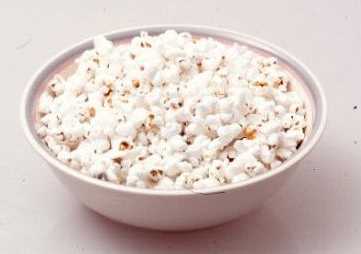![]()

There are five types of
corn and popcorn is the only one that pops. Kernels vary in color; including
red, black, gold, off-white, and many others. Some are hulless and there are a
variety of sizes, but only two basic shapes, mushroom and round. Taste varies by
type. The yellow popcorn pops largest and is the most common. Try several
different ones and see which you prefer. Popcorn is a wholesome food which aids
digestion by providing necessary roughage. Health and medical groups regard
popcorn as an excellent mealtime complement: it's sugar-free, fat-free, and low
in calories. Popcorn is also a very economical grain so it's an inexpensive way
to add fiber to your diet. It is a good source of carbohydrate energy and fiber.
(source: National Popcorn Institute, US)
Low in both calories and fat, popcorn is literally "light" - one
gallon of unbuttered popcorn weighs only 3 1/2 ounces - carrying a mere 390
calories. Why? Popped popcorn is mostly air and has no artificial colors,
preservatives or sugars to weigh it down. But because it's high in
carbohydrates, protein and other nutrients, popcorn is one of the healthiest
snacks around.
Popcorn has:
Popcorn, like other cereal grains, has one important nutritional function: to
furnish the body with heat and energy (calories). American organizations such as
the National Cancer Institute (NCI), the federal government's cancer prevention
agency, have recommended popcorn as a moderately high source of fiber that may
help reduce the risk of some forms of cancer.
The American Dental Association (ADA) includes popcorn on its list of sugar-free
snacks; and the American Diabetes Association and the American Dietetic
Association permit popcorn as a bread exchange on weight-control diets. (source:
The Popcorn Institute, Chicago IL)

![]()